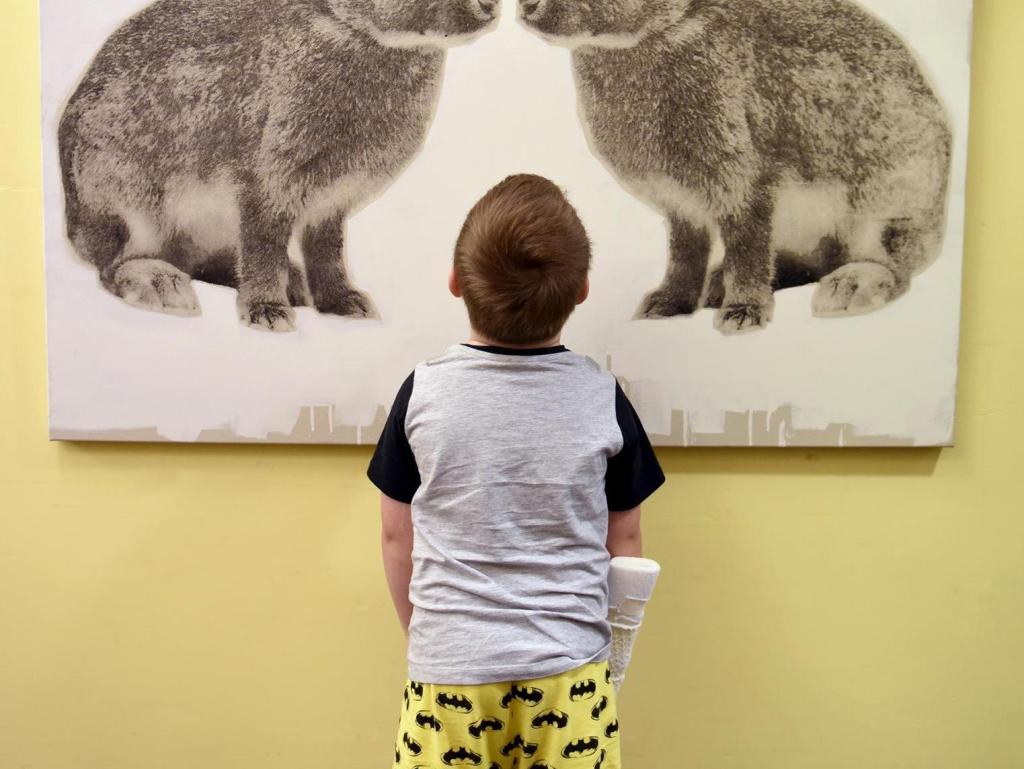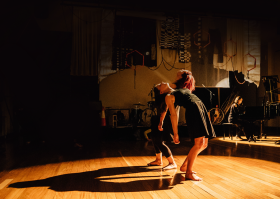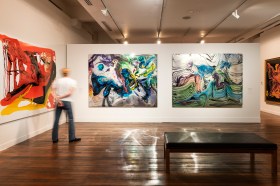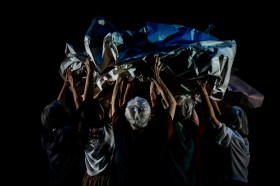Patient ponders I Love You (Rabbits) 2009 Mike Chavez
Hospitals in recent years have worked hard to move away from white walls and foreboding clinical environments. Warm colours, garden aspects, even a two-story high aquarium at the Royal Children’s are all signs that health professionals now appreciate the power of the environment to aid healing.
Art is perhaps the most powerful and persuasive weapon in this environmental arsenal and many of Australia’s hospitals invest heavily in art, generally funded through targeted philanthropy and patient donations. As a result hospitals hold some of the most significant publicly-owned collections outside of galleries.
Art display is not just a matter of ambience. Hospitals use art collections to enable patients to take control of their environment in a context that necessarily involves losing independence, to stimulate art therapy and to reduce patient isolation by bringing the broader community into the space.
Collections are rarely the focus of health arts policies, which focus on the value of participatory arts, but they are widely used by hospitals, often in combination with broader therapeutic arts activity.
Read: ‘Arts plan for every hospital’ recommends WA report
Celebrating life
Sydney Children’s Hospital Foundation runs an art program which includes a commercial gallery space, art experience workshops and a public art collection.
‘We display art on any wall that we can – we are only limited by infection control measures,’ said Timothy Talty, Arts Program Co-ordinator at the Foundation.
The program’s motto ‘Art celebrating life’ reflects the value of art in providing a positive healing environment and Talty works to make the art work for the therapeutic context. ‘We try to choose art that is representative of the style of treatment and journey of the patient. For example, in the occupational therapy department, the artwork shows lots of activity and movement, which reflects the patient journey.’
The program combines a fundraising and a community role. ‘Our commercial gallery space runs about 25 shows per year, and operates much like any other commercial gallery. We take a 20% commission, which goes directly to Sydney Children’s Hospital Foundation. Our exhibiting artists are encouraged to teach workshops at the hospital, and include patient’s artwork in the exhibitions. This allows the patients, siblings and families to have a feeling of ownership over their space.’
The SCHF’s permanent collection is made up of more established and prominent artists, while their exhibition program highlights emerging artists.
The hospital regularly changes the art works on display with an eye to the therapeutic value of variety and a sense of control over one’s environment. ‘Research shows that change within a hospital environment can result in changes in patients,’ said Talty.
For recent changes in the Adolescent Ward the hospital selected a choice of artworks and then asked the patients to choose their favourites for display.
Art is a tool
The Royal Perth Hospital has one of the largest public art collections in Australia, with more than 1000 works on display, including pieces by Sir Arthur Streeton, Arthur Boyd and Charles Blackman. Art collector Sir Claude Hotchin established the collection in 1954, believing that the public should have the opportunity to engage with art outside of galleries and in their everyday lives.
Lance Hyde spent 20 years at the Art Gallery of Western Australia before becoming curator at the hospital. He is in charge of the collection, and determines the acquisition, location and placement of the works. ‘Art is a tool used to assist in the delivery of professional healthcare. Art create atmosphere, mood and makes the built environment more interesting, and humanises our public experiences in health care,’ said Hyde.
With so many people coming and going and spaces that are open 24/7, very day of the year, hospital art is more widely accessible than gallery art, creating insurance challenges.
Hyde chooses the location for works based on the value and importance considerations. ‘Artworks have a ranking of importance in value and insurance or heritage importance. This determines their location for most of their life. All works go on display in public locations, then to a secured office area, departments, CEO spaces, Doctor Lounges, and various smaller departments.’
The RPH’s collection covers 18 buildings across the Campus site, including two gallery walls along a 50 metre venue and a Cultural Gifts Gallery. The hospital acquires work through annual funding, and also receives donated works. The general public also often donate works to departments or health staff which provide additional display opportunities but don’t form part of the collection.
Bringing artists into hospitals
St Vincent’s Hospital in Melbourne has a significant collection of more than 1300 works, including renowned 20th century Australian artists and emerging contemporary artists. Most acquisitions come through donations and the hospital’s Artist-in-Residence program. The Artist in Residence program has been running for 20 years, and incorporates 8 studio spaces in a decommissioned patient bed wing. It offers artists a yearlong studio residency in exchange for a selection of art works donated to the hospital art collection.As the largest metropolitan provider of Indigenous healthcare, the art program values the role of Indigenous art in making the hospital sites culturally welcoming to Indigenous Australians, reducing stress and cultural alienation in the hospital setting. One of the studio spaces is allocated to Indigenous artists, and the hospital holds several significant Aboriginal works in its collection. It also holds an annual exhibition of works by Aboriginal artists during Reconciliation Week.
St Vincent’s has also partnered with the University of Melbourne to offer a one week Art in Biomedical Science residency which involves access to both St Vincent’s and University of Melbourne art and museum collections archives and time with scientists in medical imaging facilities in order for the artist to explore a seed idea.
At the SCH, the ArtEx program offers art experience and education for the patients, caregivers and families at the hospital. A different artist each week works with the Sydney Children’s Hospital School to offer art workshops, then heads upstairs to visit children who are unable to leave their beds. The artists, kids and nurses work together to learn new techniques and new visual tools to interact with their surroundings. ‘Because we work for the Foundation, we are not hospital staff and can create a non-medical and non-clinical environment for the kids and their families. It creates a moment of respite.’
Read: Career spotlight: art therapy
The SCH, St Vincent’s and the RPH’s collections are registered with the Cultural Gift Program, so donors receive a tax incentive to donate works. Artists who are looking to be involved with the SCH Art Program can contact the Program directly about exhibiting and workshops.





